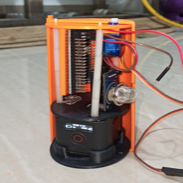Picosatellite for Measuring Greenhouse Gas Concentrations and Recording Images during Flight
DOI:
https://doi.org/10.18667/cienciaypoderaereo.697Keywords:
CanSat, Commercial Off-The-Shelf (COTS), greenhouse gas, inertial measurement unit (IMU), telemetry, remote sensing, Global Positioning System (GPS)Abstract
The VoltaX team, made up of Aerospace Engineering students at the University of Antioquia, developed a CanSat —a satellite system the size of a soda can— for the CanSat Colombia 2020 Innovation Challenge, an event organized by the IEEE Aerospace and Electronic Systems Society (AESS) Colombian Chapter. The satellite was designed to meet the mission requirements established by the organization, which included the constant transmission of data to the earth station at 1,000 m distance, measuring variables such as temperature, linear acceleration, magnetic field, and atmospheric pressure. Additionally, a gas sensor and a GoPro camera were used to estimate methane concentrations and capture high-quality images, respectively, with the purpose of monitoring greenhouse gases and using the images for precision agriculture applications. Additive manufacturing and commercial-off-the-shelf (COTS) electronic components were used to build the prototype, thus minimizing costs. Finally, functional tests were carried out on all the subsystems, confirming the correct operation of the CanSat. The designed picosatellite, identified with VOLT4201 plates, took the second place within its category.
Downloads
References
AESS, A. and E. S. S. (2020). Innovación CanSat Colombia 2020. http://ieee.udistrital.edu.co/cansat/index.html
CanSat Competition. (2020). CanSat Competition Guide 2021. http://www.cansatcompetition.com/docs/CanSat_Mission_Guide_2021.pdf
Carrero Urbina, J. (2017). El espacio, futuro de la Fuerza Aérea Colombiana. Ciencia y Poder Aéreo, 12(1), 202-208.
Chaudhry, V., & Mishra, I. (2015). Zenith: A Nano-Satellite for Atmospheric Monitoring. SAE Technical Papers, 2015-September (September). https://doi.org/10.4271/2015-01-2395
Constantini, A., Pérez, G., Busto, M., González, F., Cosentino, V., Romaniuk, R., & Taboada, Mi. (2018). Emisiones de Gases de Efecto Invernadero en la Producción Ganadera. https://repositorio.inta.gob.ar/bitstream/handle/20.500.12123/4389/INTA_CIRN_InstitutodeSuelos_Costantini_A_Emisiones_gases_efecto_invernadero_produccion_ganadera.pdf?sequence=1&isAllowed=y
Colín, Á., Bermúdez Reyes, B., Encarnación Morrobel, G., Lira Ibarra, G., Rosales, Z., Ávalos De La Cruz, L., Villarreal Méndez, M., Mendoza Martínez, J., & Álvarez, B. (2016). Construcción de un picosatélite cansat. Ciencia UANL, 81, 34-38. http://eprints.uanl.mx/11599/1/Documento6.pdf
Cornare. (2016). Actividad económica actual en el Oriente Antioqueño y perspectivas de crecimiento verde y desarrollo compatible con el clima.
e-Gizmo. (2017). LORA Module RA-02. https://www.egizmo.net/oc/kitsdocuments/LORAModuleRA02V.1/LORArev2.pdf
ESA, E. S. A. (n.d.). ESA - Design your parachute – A Guide to Landing Your CanSat Safely | Teach with Space T10. https://www.esa.int/Education/CanSat/Design_your_parachute_A_Guide_to_Landing_Your_CanSat_Safely_Teach_with_Space_T10
Faroukh, Y. M., Mohamed Abdelkarim AL-Ali, A. A., Adwan, A. O., Alhammadi, A., Shaikh, M. M., Faroukh, A. M., & Fe- mini, I. (2019). Environmental Monitoring using CanSat. 2019 6th International Conference on Space Science and Communication (IconSpace). https://doi.org/10.1109/IconSpace.2019.8905942
Fernández, A., & Medel, R. H. (2019). Estudio bibliográfico del estado del arte del desarrollo y aplicaciones edu- cativas de cansats https://www.researchgate.net/publication/332973924
Ferraz, M. C., Pereira, M. C., Greco, M., & Peiró, E. (2017). Design of a Generic Platform for an Educational CanSat. In Proc. of the 1st IAA Latin American Symp. on Small Satellites.
Fretes, H., & Gómez, R. (2018). Análisis e implementación de fotogrametría digital aplicada a imágenes aéreas | Fretes | Revista Científica de la Juventud. https://www.juventud.gov.py/ojs/index.php/snj1/article/view/17/16
Fuerza Aérea Colombiana. (2019). Fuerza Aérea trabaja en sinergia con Universidades de Antioquia para Lanzamiento de Cohetes. https://www.fac.mil.co/fuerza-aérea-trabaja-en-sinergia-con-universidades-de-antioquia-para-lanzamiento-de-cohetes
Herrada, D. (2020). L3gd20lib. Available at https://github.com/dafruit/Adafruit_L3GD20_U. Herrada, D. Lsm303lib.
Heyasa, B. L., & Galarpe R. K., V. R. (2017). Initial Development and Testing of Microcontroller-MQ2 Gas Sensorfor University Air Quality Monitoring, 12(3), 47-53. https://doi.org/10.9790/1676-1203024753
Hunt, E. R., Doraiswamy, P. C., McMurtrey, J. E., Daughtry, C. S. T., Perry, E. M., & Akhmedov, B. (2012). A visible band index for remote sensing leaf chlorophyll content at the Canopy scale. International Journal of Applied Earth Observation and Geoinformation, 21(1), 103–112. https://doi.org/10.1016/j.jag.2012.07.020
INPE. (2020). Cubedesign. http://www.inpe.br/cubedesign/2020/es/
Ladyada. (2020). Bmp180lib. https://github.com/adafruit/Adafruit-BMP085-Library
Méndez, B. E. (2017). Diseño y construcción de un microsatelite (CanSat). España.
Mohd, R., Shariff, J., Kaushil, H., Likhita, S., Bhootpur Nikhil, & Mohan Sreejith. (2020). Innovative Design, Analysis and Development Practices in Aerospace and Automotive Engineering (I-DAD 2018). Springer.
Ogata V., Contieri D., Silva L., Piñeroa, J., (2019). The CanSat project using Commercial-Off-The-Shelf components. https://www.researchgate.net/publication/340789283
Paulo Silva Neto, L., Victor, O. O., Danielle, C. P., Neto Lauro, S. P., & Jhonathan, P. M. (2019). The CanSat project using Commercial-Off-The-Shelf components. https://www.researchgate.net/publication/340789283
Seed. (2015). Grove-Gas Sensor (MQ2) User Manual.

Downloads
Published
Issue
Section
License
Assignment of Copyrights
Authors assign Ciencia y Poder Aéreo journal the exclusive rights (reproduction, distribution, public communication, and transformation) to exploit and commercialize their work, in whole or in part, in all the formats and modalities of present or future exploitation, in all languages, throughout the life of the work and throughout the world.
All contents published in Ciencia y Poder Aéreo journal are licensed under a Creative Commons Attribution 4.0 International License, whose complete information is available at http://creativecommons.org/licenses/by/4.0/
Under the terms of this license, users are free to download, print, extract, archive, distribute and publicly communicate the content of articles, provided that proper credit is granted to authors and Ciencia y Poder Aéreo, scientific journal of the Graduate School of the Colombian Air Force. Except when otherwise indicated, this site and its contents are licensed under a Creative Commons Attribution 4.0 International License.
For other uses not considered under this license it is required to contact the Director or the Editor of the journal at the e-mail address cienciaypoderaereo1@gmail.com.
The Graduate School of the Colombian Air Force and this publication are not responsible for the concepts expressed in the articles, including the metadata or the affiliation stated by authors. This is the full responsibility of the authors.





















